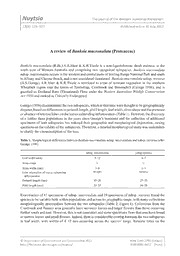
A review of Banksia mucronulata (Proteaceae) PDF
Preview A review of Banksia mucronulata (Proteaceae)
125 Nuytsia The journal of the Western Australian Herbarium 22(3): 125–127 Published online 30 July 2012 A review of Banksia mucronulata (Proteaceae) Banksia mucronulata (R.Br.) A.R.Mast & K.R.Thiele is a non-lignotuberous shrub endemic to the south-west of Western Australia and comprising two recognised subspecies. Banksia mucronulata subsp. mucronulata occurs in the western and central parts of Stirling Range National Park and south to Albany and Cheyne Beach, and is not considered threatened. Banksia mucronulata subsp. retrorsa (A.S.George) A.R.Mast & K.R.Thiele is restricted to areas of remnant vegetation in the southern Wheatbelt region near the towns of Tambellup, Cranbrook and Broomehill (George 1996), and is gazetted as Declared Rare (Threatened) Flora under the Western Australian Wildlife Conservation Act 1950 and ranked as Critically Endangered. George (1996) discriminated the two subspecies, which at that time were thought to be geographically disjunct, based on differences in perianth length, pistil length, leaf width, sinus shape and the presence or absence of retrorse lobes on the leaves subtending inflorescences (Table 1). However, the discovery of a further three populations in the years since George’s treatment and the collection of additional specimens of both subspecies has reduced their geographic and morphological disjunction, raising questions on the validity of the subspecies. Therefore, a detailed morphological study was undertaken to clarify the circumscription of the taxa. Table 1. Morphological differences between Banksia mucronulata subsp. mucronulata and subsp. retrorsa (after George 1996) subsp. mucronulata subsp retrorsa Leaf width (mm) 5–12 4–7 Sinus shape V U Sinus width (mm) 3–6 2–5 Lobe orientation of leaves subtending straight retrorse inflorescence Perianth length (mm) 15–20 27–30 Pistil length (mm) 20–25 34–38 Examination of 81 specimens of subsp. mucronulata and 29 specimens of subsp. retrorsa found the species to be variable both within populations and across its geographic range, with many collections morphologically intermediate between the two subspecies (Table 2; Figure 1). Collections from the Cranbrook and Tunney area generally have narrower leaves and larger flowers than those occurring further south and east. However, this is not consistent and some specimens from that area have broad or narrow leaves and small flowers. Indeed, there is considerable overlap between the two subspecies in leaf width, with widths of 4–12 mm occurring across the species’ range. Retrorse lobes on the © Department of Environment and Conservation 2012 ISSN 2200-2790 (Online) http://florabase.dec.wa.gov.au/nuytsia/ ISSN 0085-4417 (Print) 126 Nuytsia Vol. 22 (3) (2012) leaves subtending the inflorescence are most common in populations of subsp. retrorsa and southern coastal populations of subsp. mucronulata but are also present throughout the geographic range of both subspecies. Perianth and pistil lengths intermediate between those reported by George (1996) are common in Threatened Flora populations 3, 4, 5 and 7 (Phillimore et al. 2003) near Broomehill, Tambellup and Tunney. Across all locations and both subspecies, sinus shape and width are variable, both within and between specimens. Table 2. Morphological comparison of specimens from selected Banksia mucronulata locations. Two Peoples Cranbrook Tunney & Flat Mt Location Albany Bay & Cheyne & Weir Rd Rocks Rd Toolbrunup Beach Population (Threatened 1 & 2 3, 4, 5 & 7 Flora) Lobe orientation of predominantly straight & retrorse straight & predominantly straight & leaves subtending retrorse retrorse straight retrorse inflorescence Leaf width (mm) 4–7(–12) 4–12 (4)5–12 4–12 4–12 Pistil length (mm) 20–34(–38) (20–)26 –34(–38) 20–25 20–25(–36) 20–25 Conclusion. The morphological variation found in recent collections of B. mucronulata across its geographic range shows that there are no consistent differences between the two subspecies. Therefore, B. mucronulata subsp. retrorsa is here reduced to synonymy under B. mucronulata. Figure 1. Distribution of Banksia mucronulata specimens examined. Collections indicative of subspecies mucronulata (); subspecies retrorsa (); and intermediate between the two (). 127 Banksia mucronulata is known from over 15,000 km2 and in at least 50 locations and does not require a conservation rating. Selected specimens examined. WESTERN AUSTRALIA: [previously referred to B. mucronulata subsp. mucronulata] Twin Creeks Conservation Reserve Plantagenet Loc. 6889, 25 July 2005, A. Burchell 714 (PERTH); near beginning of nature trail, Mt Adelaide, Albany, 6 Jan. 1985, E.J. Croxford 4446 (PERTH); hill above Bettys Beach, off Hassell Hwy, Albany E, 18 July 1987, E.J. Croxford 5663 (PERTH); side of North Woogenilup [Woogenilup North] Rd (flora road), 20 km E of Mount Barker, 4 Feb. 1997, R. Davis 2492; Nymbup Rd, 700 m W of Binniup Rd, WSW of Tambellup, 8 Aug. 2000, B. Loudon BLO 31 (PERTH); 5 miles S of Mount Toolbrunup, 18 Aug. 1963, K.R. Newbey 863 (PERTH); [previously referred to B. mucronulata subsp. retrorsa] private property of N.J. & A. Witham, Flat Rocks Rd, 9.1 km S of Broomehill–Kojonup Road, SW of Broomehill, 27 July 2000, B. Loudon BLO 27 (PERTH); private property of N. & E. Burges, Tunney Hall Rd, Tunney, 28 Aug. 2001, B. Loudon BLO 56 (PERTH); reserve on ‘Trevelyn’ farm (J. & K. Spriggs), Weir Rd, S of Kojonup, 10 Nov. 1999, M. Pieroni 99/20 (PERTH); Albany Hwy, 300 m N of southern Cranbrook turnoff on E side, 24 Aug. 2009, M. Strelein 331/1/1 (PERTH); Kojonup Loc. No. 3939, Tambellup, 28 Aug. 2009 M. Strelein 331/3 (PERTH); Kojonup Loc. No. 1281, Cranbrook, 28 Aug. 2009, M. Strelein 331/7/1 (PERTH). Acknowledgements This work built on field observations made by Beth Louden. Alex George lent his taxonomic expertise and both he and Andrew Brown contributed comment on the manuscript. References George, A.S. (1996). New taxa and an infrageneric classification in Dryandra. Nuytsia 10: 313–408. Phillimore, R., Brown, A. & Loudon, B. (2003). Interim recovery plan no. 138, 2003–2008 Dryandra mucronulata subsp. retrorsa. (Department of Conservation and Land Management: Perth.) Kristine J. Brooks Great Southern District, Department of Environment and Conservation, PO Box 100, Narrogin, Western Australia 6312 128 Nuytsia Vol. 22 (3) (2012)
